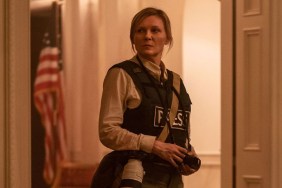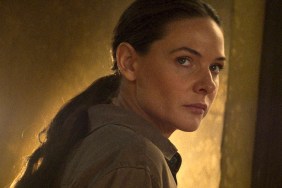Ever since he received two Oscar nominations in the same year, director Steven Soderbergh was a filmmaker who needed no introduction, and its somewhat surprising that was just eight years ago, considering how prolific he’s been, often cranking out two movies a year, whether it’s the three big-budget “Danny Ocean” movies he did with pals George Clooney, Brad Pitt and Matt Damon or more art-driven films like The Good German and Solaris.
His latest, The Girlfriend Experience, continues the tradition of indie filmmaking he’s frequently revisited in the 20 years since Sex, Lies, and Videotape. It’s the second film in Soderbergh’s deal with HDNet, starring adult film star Sasha Grey as high-priced New York escort Chelsea, who balances her demanding job with spending time with her personal trainer boyfriend (Chris Santos) until she connects with a client, threatening her existing relationship. Mostly improvised, it follows Grey as she interacts with various people who might be able to help her career, including the creepy owner of an adult entertainment website, played by film critic Glenn Kenny, who hopes to get a “review copy” of Chelsea’s services.
While it’s already been playing on video-in-demand for a few weeks, having seen the film twice on the big screen, it’s an amazing looking film that really deserves to be seen in that environment.
ComingSoon.net had a rare chance to spend a half hour with the prolific filmmaker talking about the process of making The Girlfriend Experience. We’d been wanting to do longer interviews with filmmakers for a while now, and we were thrilled to learn Soderbergh felt the same way, so it was great to have an opportunity to talk to him at length about a New York-based film we genuinely love, as well as other aspects of his career.
ComingSoon.net: We spoke a few years ago when you were promoting “Bubble” and you had signed a deal with HDNet to do five more movies using this process, so at what point did this project come about?
Steven Soderbergh: This is like spring of ’06 we wrote the outline for this, so it’s only a couple months after “Bubble” came out. It seemed to be a story that could fit within this methodology that I’m hoping to employ on all six of these. David (Levien) and Brian (Koppelman) and I kind of knocked this outline out and then kinda stuck it in a drawer ’cause I wasn’t sure when I was gonna get to it. Then of course the (Elliot) Spitzer thing broke a year ago and I actually felt like, “Oh, maybe we want a little bit of distance from that.” As it turned out, it wasn’t really a factor, so we’d been percolating on it for a while. We did a lot of interviews in the spring of ’06 and then we did a second round just before we started shooting like last fall. That’s where the hobbyist idea came in. It wasn’t in the original outline. In the intervening two years, the escorts we talked to said that this was becoming more of an issue for them, these reviewers that were getting kinda increasingly just snarky, you know? Just how frustrating it was for them.
CS: I wasn’t even aware there were sites in the adult entertainment industry that reviewed escort services. The most surprising thing to me was that you only shot this last October and November and how much of this stuff is just so recent and timely. Once you started shooting, was this a faster process to finish it than normal?
Soderbergh: Yeah, by design the shoot’s very quick and the edit’s very quick and they’re designed to be churned out in a way. I don’t mean that in the sense that nobody cares, but the design of them in terms of how much money we’re spending. In this case, we have an element of topicality that we want to maintain, so we were trying to turn it around quickly. Initially I wanted it to come out Valentines Day, but as it turned out, Magnolia felt like we couldn’t get the machine up and running in time, so we bagged that. The good news is that the economic stuff is still going on, and I think the thing that saves it from being harmed by the topicality is the fact that it’s not the core of the movie. The narrative doesn’t turn on some topical event, it’s just this filigree that’s going on around the edges that makes it feel specific.
CS: Were all the actors sitting down together and all of the economic stuff just came up in their improvised conversations?
Soderbergh: Yeah, that’s where everybody ended up going which to me was sort of telling in a way that may not be apparent at first blush. For instance, in “Bubble” when we would do some sort of structured or extended improvisation, invariably the characters would end up discussing something personal that happened to them. They would bring their personal history into the conversation. People in this movie could’ve done the same thing. They chose to talk about money, like every one of them, and that tells you something both about this specific slice of people in Manhattan and then also something about Manhattan and then also something about the country. I mean, not that anybody would know that that’s how it all ended up here, but it was certainly interesting to me, given that they could talk about anything they wanted that everybody basically wanted to talk about money.

CS: That’s one of the many layers of the film, the fact that despite the economic problems, people still have money to pay for company and sex from these women. There’s also its explorations of being a real girlfriend vs. fake girlfriend – Christine vs. Chelsea. When you went into this, did you have any idea that so many different things would come out of it?
Soderbergh: Well, you’re hoping. What’s fun about it is you’ve created a net of a certain size and a certain shape that’s designed to catch certain things, but you never know until you’re rolling whether you’re gonna get what you want or not. What you have to do in a way is let go of the idea of what you want and release yourself to what you get and sort of let it move where it’s gonna move and then, the trick is you’re collecting this material and then you sit down and you break it all down into pieces and build bins that have different subject matter headings and then I’ll start to connect things like, “Oh, that reference in this scene is connected to a reference in this scene. This section of the film is gonna revolve around this idea.” Then I’ll move them and you sort of just begin to mold it out of what you’ve got.
The key is to have this sort of basic structure so that people kind of feel like they’re moving in a direction and it’s not just a free-for-all. At the same time, I’m literally encouraging as we’re getting ready to shoot something and I’m saying, for instance, Sasha and Chris Santos, the breakup scene where she comes in and says, “I’m going away.” I’ll have a conversation with Sasha where I’ll say to her, “Under no circumstances are you staying in this apartment tonight and going on this trip. No matter what happens you are leaving this apartment to go on this trip.” Then I take Chris aside and I say, “Under no circumstances should you let her go on this trip. Like, do whatever you have to do to keep her from going on this trip.” So you’ve given them their goals. They’re in opposition and then in that case, I’m watching to see how long it’s gonna take one of them to pop because that’s a very polarizing scene for people because it goes on so long. What I like about it is, it sounds real to me. It feels like that circumstance in the sense that it’s repetitive. Both of them keep thinking. “If I frame my position in a sentence that’s slightly different I’m gonna get a different result.” They both keep thinking that and they keep coming back and back and back. They’re both sort of using language that you can tell they’ve heard somewhere else that they’ve incorporating from a movie or something that somebody said somewhere. Again, they’re trying to find a way to unlock this. They’re convinced, “I’m gonna say this thing and it’s gonna make everything okay.” It’s just not happening. Eventually, it implodes.
CS: With that scene in particular, was that 20 minutes of straight shooting and then just grabbing a chunk that worked as a whole?
Soderbergh: I think the shot ended up being like five and a half minutes. I think the whole take was probably 10, it continued on from there and then she finally just gets up and goes to the back and says, “I’m going to pack and then I’m leaving.” So like I said, I shot it and I thought, “Okay, I know I can make something out of that. I don’t know how I’m going to use it, I may fragment it, I may whatever, but I’ve got enough to build something with.”
CS: A lot of people try to make naturalistic movies using improvisation and non-actors rather than a written script. This seems natural but it also seems like every single line could have been written by a good writer. Even so, it’s somewhat strange to see two writers credited for a movie that’s largely improvised. Did they help work out the structure after you’d finished shooting?
Soderbergh: No, it was really just the three of us kind of sitting down and generating this detailed scene-by-scene breakdown of what we were gonna shoot and what the subjects are in each of the scenes that we want the people to hit. But from that point on, yeah, you’re fishing.
CS: Was all of that figured out before you started shooting, or was some of it done while shooting when you realized you had to tie things together?
Soderbergh: No, while we were shooting we didn’t add any. We stuck to the outline and we shot in sequence ’cause that’s very helpful for the performers to sort of be moving even though I knew when we were shooting it that I was gonna fragment it, which is why I was very conscious before shooting a scene somewhere that I know it’s gonna be part of a kind of memory sequence. I’m trying to pick up images that I can use as recurring keystone images that I layer in that you realize, “Oh, she’s going upstate. Now I know why in seeing that.” You know, stuff like that.

CS: Shooting chronologically probably was important to working with Sasha, but how does that work as far as locations? Except for the UN scenes in “Che,” I couldn’t think of another movie where you actually shot on location in New York City.
Soderbergh: I did three shots at the beginning of “Full Frontal.” (This) was the first time I’ve really made a New York movie.
CS: So you did it chronologically, shooting at specific locations but without the budget to really block off streets and sidewalks?
Soderbergh: Well, that’s the good news and that’s why I’m so happy with all the street stuff. The Red camera is so small and really doesn’t present like a movie camera, so I could set it up on a tripod and it would be me and somebody sort of standing next to it to kind of block it and then we’d tell Sasha, “Go across the street and walk toward us.” Nobody would know this was happening and you’d get a much first of all, we got this free production value, like these giant street shots, but also, the way people are moving doesn’t look like that typical, “Background action!” It has a more naturalistic feel and that’s because of our totally stealth, low impact working method. All in, it’s about ten people.
CS: So in New York, you can get away with ten people standing around making a movie.
Soderbergh: Oh yeah, and if we’d go out on the street, it’d be just me and two other people and we’d keep everybody else away. Most people, if you saw us on the street you’d go, “Oh, that’s a news crew,” ’cause we looked like a news crew. The camera looked like a news camera, small tripod and two people standing next to it. You just felt like, “Oh, they must be shooting some exterior shots or something for some news story.” It just didn’t feel like that. There’s no trucks, there’s no lights, there’s nothing.
CS: A lot of attention has been paid to Sasha’s performance and deservedly so, but I want to talk about Chris because he really is in the movie quite a bit, probably 30-40% of the movie. I want to ask how you found and cast him and the decision to spend so much time showing his everyday life as a personal trainer.
Soderbergh: He was a friend. He was training David Levien, the writer who plays David in the movie. So when we were talking about the movie and I said, “I want the character to be a personal trainer. I want them both in the personal service business.” He said, “Oh, you should meet Chris. He’s that guy.” So, I met with Chris in Los Angeles and sort of walked him through what we were gonna do. I mean, that’s sort of him. He’s a very open, verbal, energetic guy and I thought he’d be great for this.
The trickier part was what in the outline was called Client F, which is David, that was how he was referred to at the time. I was talking to Carmen, the casting director and Greg the producer ’cause I wanted him to be somebody that worked in the entertainment industry. “How do you picture this guy?” I said, “He’s like David a little,” and both of them said, “Well, why don’t we just get David Levien?” I wanted a contrast between the two of them. I wanted there to be something, I wanted him to be a little older, I wanted him to have a certain sense of gravitas. I didn’t want him to be a caricature of a Hollywood person. David’s a very genuine, sincere person, but also, nothing escapes him. He has a very sort of detailed vision of what’s going on around him. You cannot throw bullsh*t past this guy. So I wanted someone that Chelsea would meet and feel like, “Wow, he’s so different than Chris.” It took a little bit of strong arming to get him to commit to doing it, but in the last scene they have together which is the first scene they meet in the hotel room, when she comes in and is upset, he’s so good, he’s so still. The way he looks at her and the way he listens to her, I’m telling you, there are a lot of actors it would take you half a day to get them to strip it down to that, the way he’s just looking at her and listening. I think she’s really good in that scene too where she gets upset. You finally get the sense that there’s something going on, that you really see, “Oh, she does have to work to keep this stuff pressed down.” So those are the pleasures of working in this way. You see things happen like that in front of you that are unexpected.
CS: I didn’t realize that was David, the co-writer of the film, until Sasha told me; I watched the movie twice without realizing it. This is such a strange cast because Brian found Sasha, David found Chris and you have a real critic playing an exaggerated version of a critic.
Soderbergh: Exaggerated?

CS: Well, yeah, I’d say so. The character Glenn plays might be the creepiest movie character I’ve seen since Dennis Hopper in “Blue Velvet.”
Soderbergh: Really? First of all, that location’s fantastic. When Greg and Rob Striem the location manager said ’cause that wasn’t what was scripted at all, it’s an apartment and they said, “Look, this is a sort of left field idea, but we found this furniture store in Brooklyn and you gotta check it out.” When I saw the pictures, I went, “That’s spectacular.” We didn’t touch anything. The combination of that and what he’s saying is really unnerving.
CS: It kind of reminded me of Philip Seymour Hoffman’s character in “Punch Drunk Love,” how he was running a phone sex operation from a furniture store. It also takes the idea of a casting couch to another level. Having directed Julia Roberts to an Oscar, how did you feel Sasha stood up as an actress? When I spoke to her, she was well aware of the stigma about coming from the adult film world. Do you feel she has what it takes to get past that and go up against other actresses who come from more traditional backgrounds for roles?
Soderbergh: Look, if I had something else that I thought she was good for I wouldn’t hesitate to use her again. I think how she’s used is really gonna determine whether or not her career moves in this other direction. I don’t know how much of a conscious or unconscious stigma there is. I don’t know that people care that much. I think it’s really gonna depend on her and the choices she makes and how she performs. Porn has become so mainstream that I just don’t think people are really thinking, “Oh, I don’t want to see that because there’s a porn actress in it.” The level of traffic would indicate that people really don’t have a problem with it. It’ll just be interesting.
CS: It’s really something you almost can’t avoid talking about when interviewing her, which is unfortunate. With other actresses, you don’t really ask about their previous jobs of being a waitress or whatever they were before. It never really comes up. But with Sasha, I feel like it will always come up.
Soderbergh: Yeah, but the thing about her–the reason she’s such a mold breaker–is her back story and her attitude about the adult industry is just very atypical. She’s not the kind of person that normally ends up in that business. The fact that she did it by choice because she felt like, “I have this part of me that’s gonna speak. Well, I have two options, I could go work in an office somewhere and then on the weekends go out and try and find somebody who’s into the same sh*t I’m into, or I can turn this thing that’s inside of me into a business and make money off of it.” Those are two choices.
CS: It’s pretty amazing actually, even the fact that she’s been working on a documentary about her three years in the adult entertainment industry, and she’s only 21-years-old.
Soderbergh: Yeah, she’s 21. She has a lot of very formative years in front of her. The years of 21 to 24 for me, a lot of stuff happened to me personally that ended up generating a lot of material. It’s a crucial period in your life.
CS: Obviously you’re very comfortable both working in the studio system and making films independently, you do jump around a lot. The advantages and disadvantages to both are very obvious. I was curious about that because you don’t really see a lot of filmmakers who can do that, who can easily jump back and forth from one movie to the next. Is it just something in way your brain works and you can do that?
Soderbergh: Well, I think it’s about understanding the business and understanding the place for art in the business. I mean, it’s really about analyzing, let’s say there’s an idea that you’re attracted to and you feel could be a movie. Then you’ve gotta analyze, “Well, what is the audience for this? Who’s gonna go see this thing potentially? On what scale should it be executed? If the appropriate scale of execution is disproportionate to how big you think the audience is, can you do it another way? If you can’t, should you continue to try and talk someone into doing it or not?” Now, I make mistakes. “The Good German” lost every penny – Warner’s lost every penny they spent on that movie. There was a sort of calculated risk. In retrospect, we made an assumption that we would get enough critical support to sort of build the movie out through a platform release. It didn’t happen, it just didn’t happen. We got crushed and we couldn’t get any traction because nobody like it.
CS: But can you separate the artist who wants to make a certain type of movie from the producer/businessman who knows that you have a certain amount a movie needs to make back?
Soderbergh: Well, I look back on that and as a piece of art, that’s as close as I’ve ever gotten to getting what I had in my head. The problem is, look, with $32 million, me, George, Cate, and Toby all working for very, very, very low money to pull it off. I look at it now and if I had a similar thing now, I would say, “If I can’t figure out how to make it for $15 million I’m not gonna do it.” You can’t just keep losing people money. There’s sort of an inverse thing happening on the “Ocean’s” movies, which is: within the parameters of a big budget movie with stars in it, how weird can I get? What sort of stylistic tricks and loops can I inject in it without totally pissing everybody off? It’s fun to see how much of a piece of crazy pop art can I put into this? So that’s a long way of saying I think you’ve just gotta be smart about. What is the idea? Who’s it for? How much is it gonna cost to do it properly? On a gut level, do you feel like this has the possibility of returning its investment? You’ve gotta find this balance of doing stuff that you want to do and acknowledging that this is a very expensive hobby.

CS: The next two movies you’re doing are book adaptations, “The Informant” and “Moneyball,” working with two actors you’ve worked with before (Matt Damon and Brad Pitt) albeit as part of an ensemble. Can you talk about those two movies and how you read those books and decided those would be movies you’d want to make?
Soderbergh: We heard the story (for “The Informant”) on NPR, got the rights to the book, started working on it – this is 2001, and this would’ve been Jennifer Foss and Ben Cosgrove, who were running Section A. We picked up the book, I sent it to Mattie, Mattie said, “I’m in.” We hired Scott Burns to write the script. It was sitting there waiting for a long time, waiting for a slot for me and for Matt. Again, that’s a $22 million movie and we decided at a certain point to make it a comedy, which I think was the best move. It’s not “The Insider,” it’s more like “Citizen Ruth.” I think Matt’s genuinely hilarious in it, playing a kind of… sort of Willy Loman on acid.
CS: So I’d guess that “Moneyball” is more serious?
Soderbergh: No, it’s gonna be funny. I think it’s gonna be dramatic, but I think it’s gonna be funnier than people expect. That’s another situation where I’m injecting a lot of real people playing the roles.
CS: Yeah, I was reading that you were doing some documentary-type stuff for that movie. You mentioned that “Informant” started in 2001, and you seem to be attached to so many different projects that you’re working on at any given time.
Soderbergh: Well, I try, as a director… there’s only like two movies that I’ve developed that I haven’t made. I like to have a lot of plates spinning, but at a certain point I want to grab that plate and put some food on it. So yeah, I think “A Confederacy of Dunces” and “Human Nature” are the only things that I tried to get going and couldn’t.
CS: But in general when you’re making a movie, you’re always prepping something else?
Soderbergh: Always prepping, yeah.
CS: I wanted to ask about how “Che” did internationally, because I thought it would be a home run in Spanish markets, but I couldn’t find any international box office information.
Soderbergh: Yeah, sometimes they don’t. I don’t know why they’re not tracking that. Yeah, we got killed by piracy. We did really, really well in Spain when we opened in September, then after that every Spanish speaking country we went to we got crushed because the DVD had been out for months. It did well in Japan, and it did well in the UK. It hasn’t come out in Germany yet. We did so-so in France; France we were disappointed; we thought we’d do better. Yeah, like I said, in Mexico and South America we just got killed. At some point I’m gonna sit down and collect all of it and find out exactly what we did.
CS: At Sundance this year, they were celebrating the 20th anniversary of “Sex, Lies, and Videotape” which to me seems surreal. I’m not sure how it feels to you. Filmmakers, critics and moviegoers often reference Fellini and Cassavetes and movies that generally came out over 20 years ago, but you don’t really hear people doing the same thing for movies from the last five years. For instance, “Good Night, And Good Luck” was a great movie, but you don’t really hear people today talking about it. I was curious about how you feel about that?
Soderbergh: Yeah, there’s so many more movies being made that the burn rate is faster and like you said, things don’t stick culturally. They don’t stick the way they used to. When people made “Chinatown” that sort of lodged itself into people’s consciousness and never went away and I don’t know that movies function that way anymore just because of the volume of stuff that’s coming at people. You just don’t have those kind of benchmarks anymore. There’s a benchmark every six days it feels like.
CS: As a critic obviously I see way too many movies, but I was thinking that as someone who studies a lot of older films, I wondered why you thought movies made these days just don’t stick with people as much as the films of the ’80s, ’70s and earlier.
Soderbergh: Yeah, I mean, it doesn’t hurt my life, but it’s frustrating to think that, like I said, even movies that hit don’t have the kind of influence that “The Godfather” had. Like the equivalent big box office hit, it becomes a big box office hit and people talk about the fact that it made all this money, but it doesn’t have this cultural impact of something like “The Godfather.” Although “Avatar”… Holy sh*t.
CS: Have you actually seen some stuff?
Soderbergh: I’ve seen some stuff. It’s the craziest sh*t ever.
CS: Wow, that’s a big recommendation.
Soderbergh: Yeah, that could just negate everything I just said.
The Girlfriend Experience opens in New York and L.A. on Friday, May 22, while continuing its run on HDNet’s Video-on-Demand. Look for our exclusive interview with Soderbergh’s leading lady, Sasha Grey, sometime next week.









